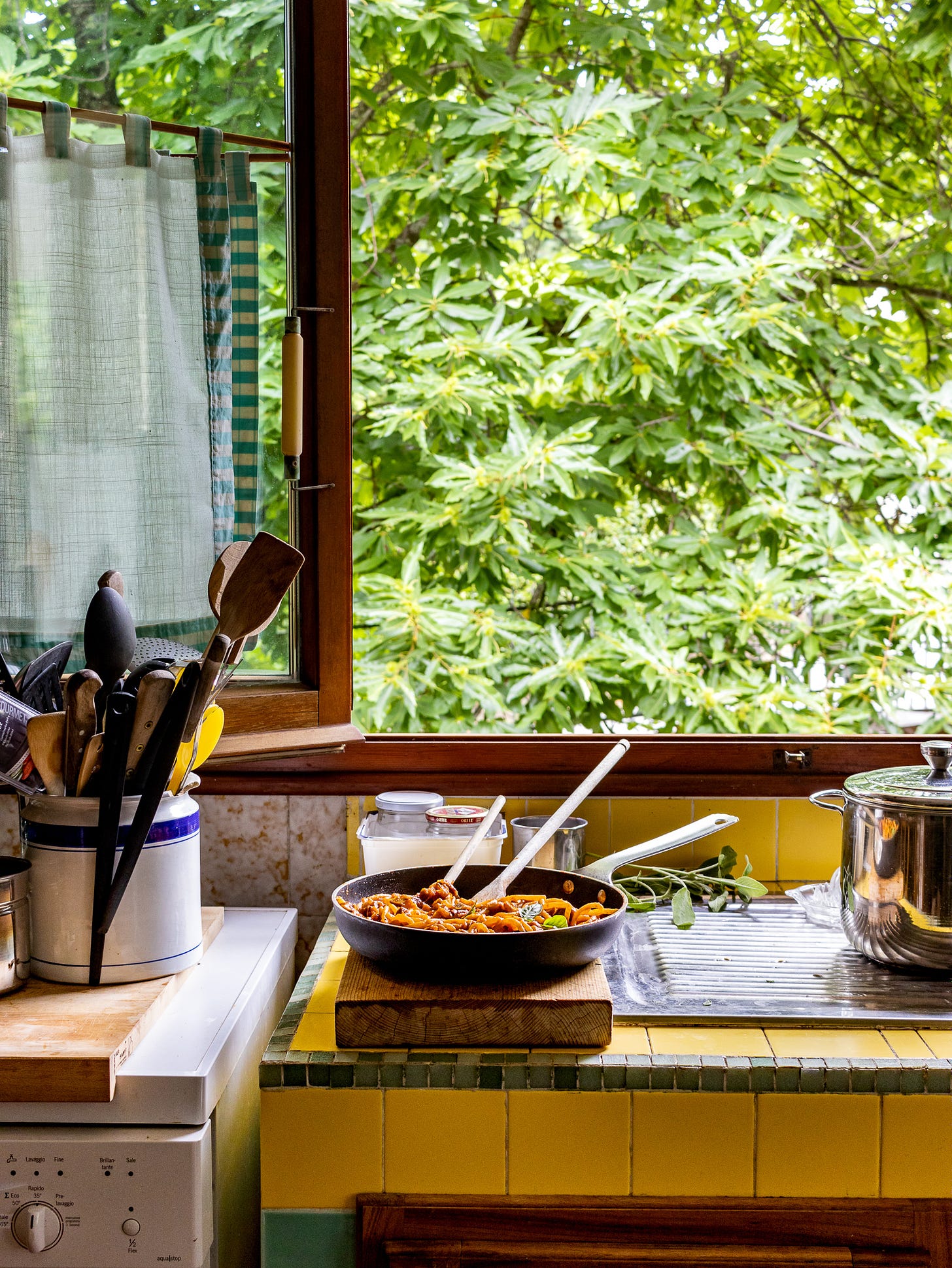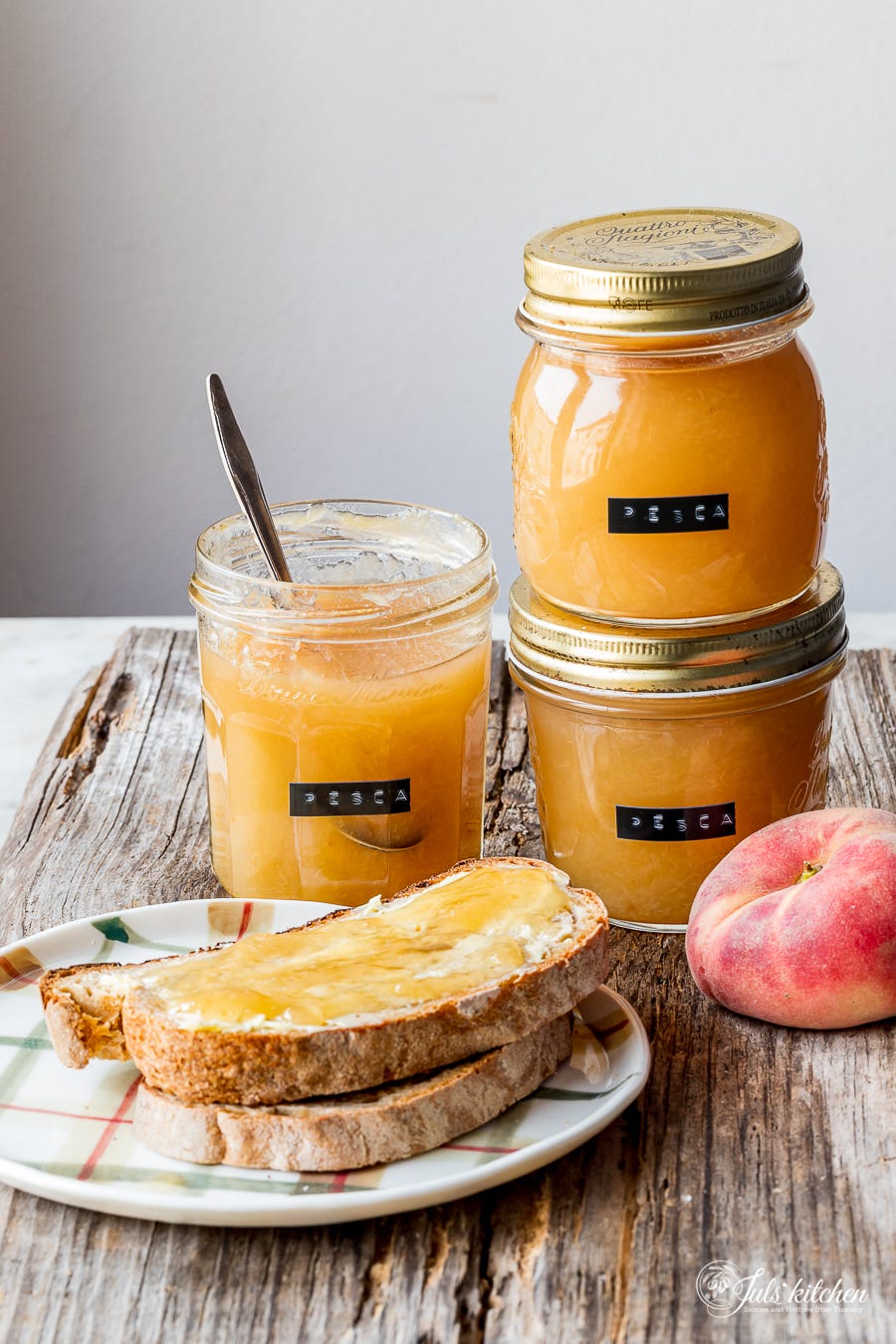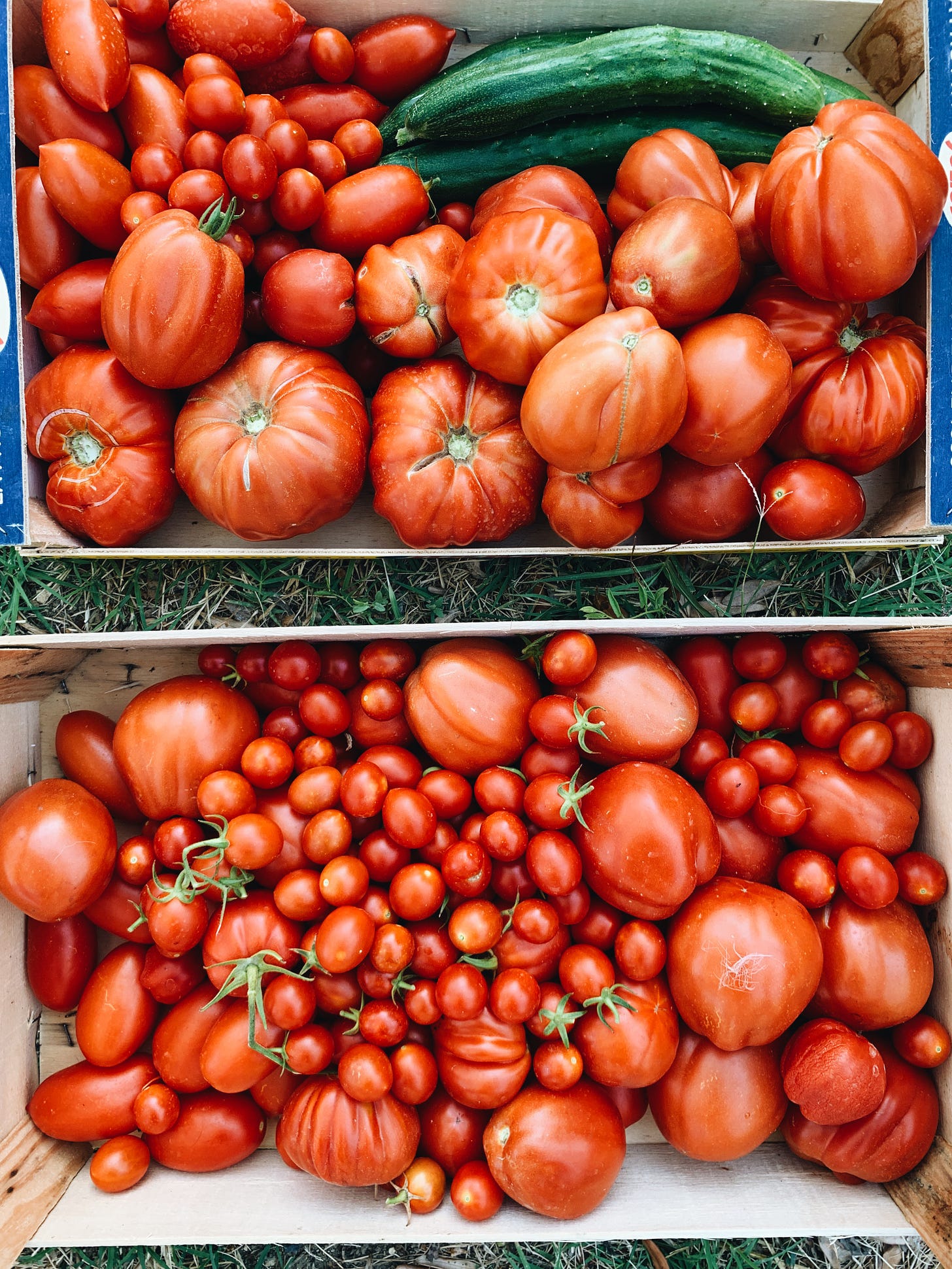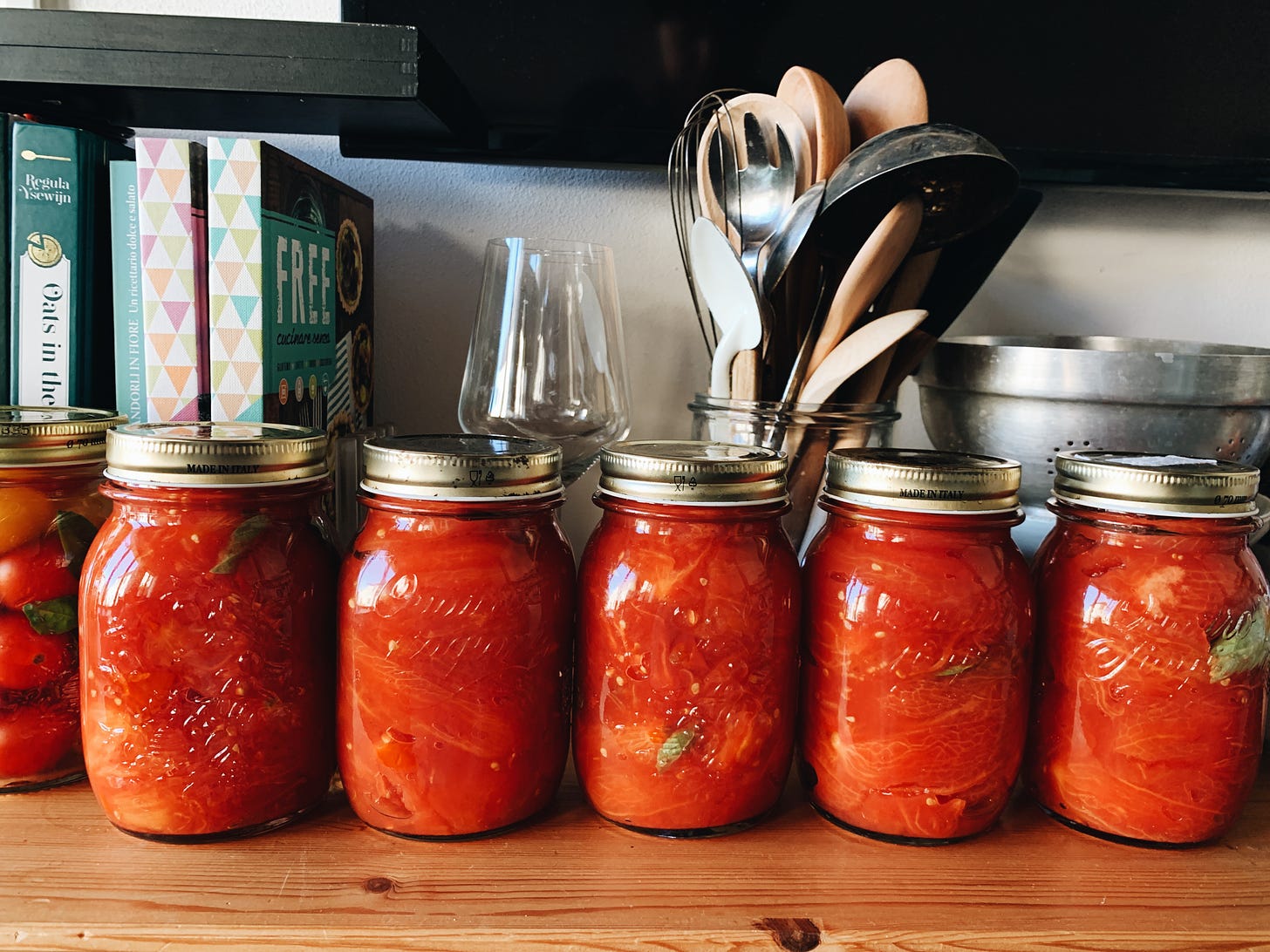Welcome August - a peach jam + links
A letter with 10 recipes to cook this month, and an insight on what I'm reading, watching, listening to, and cooking right now.
I’ve always lived summer as the season when you get ready for winter. If in the mountains, as my friend Vea shared on Instagram, it is a necessity, here in the Tuscan countryside it is more a feeling, a way of living.
Summer is a season to reflect and refocus, to harvest the fruit of a year of work, getting ready for the new start that September ensures every year.
During the summer I read books that help me in my job - books about writing mainly, but also about photography, or cooking -, we take time to revise what we’ve done, and we plan ahead. This year, for example, we’ll be working on our blog, too, to give you a better experience when you’re searching for a recipe, or simply catching up with our stories.
In the kitchen, I preserve the bounty of the season, inspired by what my mum and grandma have always done. Nothing makes me feel happier and safer than a well-stocked pantry. All my preserves will then become the backbone of quick, easy recipes in winter, and a ray of sunshine for my winter breakfasts.
What I am cooking
Summer is all about quick meals with seasonal vegetables, as panzanella and caprese, and preserves. At the moment I’m testing and retesting all the seasonal recipes included in our next cookbook, which means I’m going through basketfuls of summer vegetables. I couldn’t be happier.
I’m also preserving with rapture whatever is in season. I made canned peeled tomatoes, tomato passata, garlic tomato sauce. I bottled cherry tomatoes with a leaf of basil, made more than 2 kilos of basil pesto, and made a peach jam with flat white peaches (I’m sharing the recipe on the blog today), and with what was left at the bottom of the fruit bowl. In the next weeks, I’ll be making my annual batch of minestrone, blackberry jam, and blueberry jam if we’ll make it to the Tuscan Appennini for a day. Let’s not forget vegetables, too. I’m planning on pickling cucumbers and making a few jars of giardiniera.
What I am reading
Tommaso spotted this book during our trip to Dublin years ago, wrote the down into his secret list of Giulia’s possible gifts (how adorable is this?), and surprised me with it for my birthday. Eating Words: A Norton Anthology of Food Writing is a collection of food writing that extends from the Old Testament and Latin Horace and Petronius to more recent examples such as Gertrude Stein, Julia Child, Hemingway, David Foster Wallace, and Michael Pollan. I just would love to have days of 48 hours to have the time to delve into this book, an iced tea in one hand a pencil in the other, as when I’m struck by excellent food writing I feel the urge to underline a sentence, and immediately copy it into my little notebook of words and phrases I love.
What I am listening to
Cicadas while I’m writing and ‘80s music while I cook.
But you should be listening to the second season, a special Summer Edition, of Cooking with an Italian Accent. We worked on four special episodes for the summer, with guests from all over Italy engaged in conversation about some of our favourite themes, from food to tourism, from cookbooks to personal memories. Each episode will give you the chance to explore an Italian region and will give you tips on how to travel more sustainably to some of the most iconic Italian destinations.
What I am watching
Why Waste? is the exclusive video series from Fine Dining Lovers, featuring Massimo Bottura and his team of chefs, that teaches us how to cut food waste in delicious and imaginative ways.
Individual households are responsible for the majority of the world's food waste, around 61% of the total, according to a UN Environment Programme report. It's a shocking statistic that we can all have a hand in reducing by getting a little creative in the kitchen.
Watching this series, you will learn tips on how to store ingredients such as bread and milk to extend their life and waste less food, how to wrap cheese to make it last longer, and you will also discover new creative, sustainable recipes.
Where I am dreaming to go
Mountains, possibly the Alps. I’m really missing green meadows dotted with cows, forests and hiking trails, polenta with melted cheese, and good local butter slathered on rye bread. I’m so tired I would really need 2 weeks up there in the mountains, exploring local producers, walking, sitting by a lake reading a book, eating alpine food and feeling very, very small in the wild Nature.
Two years ago we went to @pinetahotels in Val di Non to celebrate our first wedding anniversary. It was such a relaxing and inspiring week! I hope we’ll be able to go there with Livia soon.
Please consider sharing it with your friends and family or on Social Media if you like this newsletter. It will help us grow! Thank you! xx
Cooking with an Italian Accent
Don’t miss the next episode on Tuesday. We’ll be travelling to the mountains to visit my friend Vea Carpi. She is a cook, a farmer, a sourdough baker, and she is also passionate about wool. She has a maso up in the Trentino mountains and agritourism with her family. We are both from Tuscany, but we met there, in her farmstead, where we were greeted as part of her family. We attended one of her sourdough baking courses and learnt about her life in the mountains.
Here you can listen to the past episodes:
Episode 2×02 – Liguria e Cinque Terre: in conversation with Enrica Monzani. We also had a live talk on IG delving into Liguria, Cinque Terre, and other Ligurian hidden gems. We talked about recipes and local products, about Genova and its street food. Listen to this conversation to discover the best vegetarian recipes of the Ligurian cuisine, and how to experience Cinque Terre in the most sustainable way. Enrica also gave us a little anticipation about the cookbook she is writing!
Episode 2×01 – Let’s celebrate: Happy (40th) Birthday Giulia! This is the first episode of our second season, a special summer edition, a short collection of 4 episodes. In this episode of Cooking with an Italian Accent, I switched roles and asked our friend Valentina Dainelli, known online as Toomuchtuscany, to be the host of this conversation: I felt it would have been much more interesting for you than listening to a soliloquy.
Ten recipes to cook this month
As this is the preserve edition of Letters from Tuscany, here I am with 10 recipes to preserve the seasonal produce this summer. It is just a small collection of my favourite ways of preserving the season.
Apple and blackberry jam. Blackberry jam for me is THE jam, the one and only, its flavour must bring back to mind exclusively blackberry, pureed and closed in a jar. I can’t stand other flavours but blackberries, I love this jam in its purity. Adding apples was, therefore, a cautious thing. I’d say I was very suspicious at the beginning… what was so powerful to convince me? A book, The Flavour Thesaurus, a must-have for curious foodies.
Apricot jam. When you bring home three whole boxes of apricots, you need to find a way to use them before they decide on their own to turn into jam. So, let’s make jam! Mum, abiding traditions, followed her canonical recipe, but I’ve played around with my jars of spices in search of a special aroma to make these apricots even more special.
Blueberry jam. The main purpose of our Apennines adventure was blueberry jam. We froze two bags of blueberries for winter smoothies and porridges, I baked a crostata – as I was dreaming about its juicy filling up there in the mountains – then the rest of our harvest became a jam: thick, pitch-black jam for future cakes, breakfasts with bread and butter and sudden cravings.
Preserved apricots in syrup. The apricots quickly rinsed and pitted are preserved in a syrup of water, sugar and lemon zest. It is even faster and more immediate than making a jam, and I must admit that, in the pantry, these are among the most beautiful jars.
French beans preserved in oil. The French beans preserved in oil with a clove of garlic, black peppercorns and bay leaves are among my favourite preserves for the winter: thanks to the short cooking in water and vinegar, they are crisp and al dente. They are excellent to kick up the flavour of boiled meat or as a vinegarish side dish to a fluffy cheese omelette, providing a nice contrast in texture and taste.
Pomarola, the Italian tomato sauce. A dish of pasta, a good deal of intense red and glossy tomato sauce, a generous sprinkling of freshly grated Parmigiano on top and some basil leaves, a charm to give that extra balsamic touch to turn a simple dish of pasta into a memorable dish of spaghetti, a dream come true for many foreigners passing through Italy. Here you will find the recipe to make pomarola, a simple tomato sauce flavoured with carrots, celery, and onion.
Tomato purée. Once again, the protagonists are the tomatoes, in a simple version, pure: the preserve, a universal name that does not need specification, because, in my house, the preserve is exclusively the preserve of tomatoes. In the collective imagination, the tomato is one of the elements representing Italy, along with mozzarella, olive oil and pasta.
Spicy tomato jam for cheese. This spicy tomato jam holds the memory of the summer sun in its bright colour and its rich flavour of ripe tomatoes, slightly warmed by a hint of chilli. It marries a wedge of aged cheese beautifully – a Tuscan pecorino or spicy provolone, for example -, but you can also use it in a sandwich with roast beef, melted cheese and caramelized onions.
Tomato paste. When I asked my grandma to tell me more about her stews and soups, I noticed that she often mentioned an unsuspected ingredient, a tablespoon of tomato paste. Now, you should know that since I was born, I’ve seen grandma and mum saving a few days in late august to preserve tomatoes: they would prepare jars of tomato purée, tomato sauce and peeled tomatoes for the winter. We would use them in our Sunday pizza, for a hearty meat sauce or in weekday pasta al pomodoro.
Five ways to preserve summer herbs. An example? The easiest way to preserve the basil is to stash it in a jar of fine sea salt. Then, alternate layers of salt and layers of basil leaves carefully washed and pat dry. It will be your go-to herb for chicken stock, minestrone and soups in winter: add a basil leave and a pinch of salt to your pot and breath in the balsamic summer air.
What are you planning to cook this month? Is there something you are excited to reintroduce to your cooking routine? Let me know in the comments, I’m always happy to add new recipes to my cooking repertoire.
Are you in the Southern Hemisphere?
Let me tempt you with mixed citrus marmalade, candied citrus peels, and quince paste.
Are you interested in more original recipes?
So you should consider subscribing to our weekly newsletter.
What you missed this month: Mozzarella in carrozza, Biancomangiare alle pesche, Salento and Matera, our foodie guide, Sicilian swordfish, and eggplant involtini.
—-—-—
🏖We’ll be taking a break in our weekly subscription-based newsletter and we will resume our regular schedule on the 6th of September. We need some time to focus on our cookbook and on a blog restyle. But don’t worry, your subscription will be extended for 4 weeks, so you won’t lose a single email or recipe.
—-—-—
If you join us, you will receive a new original recipe inspired by ingredients, season, or tradition every week. You will discover Italian classics, weeknight ideas with an Italian flair, reliable dishes to add to your cooking repertoire.
Subscribing to the newsletter, you will support us directly. Whenever you decide to join us, you will have complete access to the whole archive of already published recipes and stories.
We love Letters From Tuscany as it is like having our own independent publication: we test, photograph, write each recipe just for you. It is a way of sharing great content, recipes that we like, created to inspire you, to bring a little taste of Italy to your kitchen, for you and your family.
Join our virtual cooking classes
We’ve been working on new courses and videos. Read more about the courses here on the blog to stay updated.
Virtual cooking courses currently available:
Each course includes:
step-by-step cooking demonstrations,
a PDF with ingredients, tools, and instructions of each recipe,
lifetime access,
free access to upcoming new recipes.









